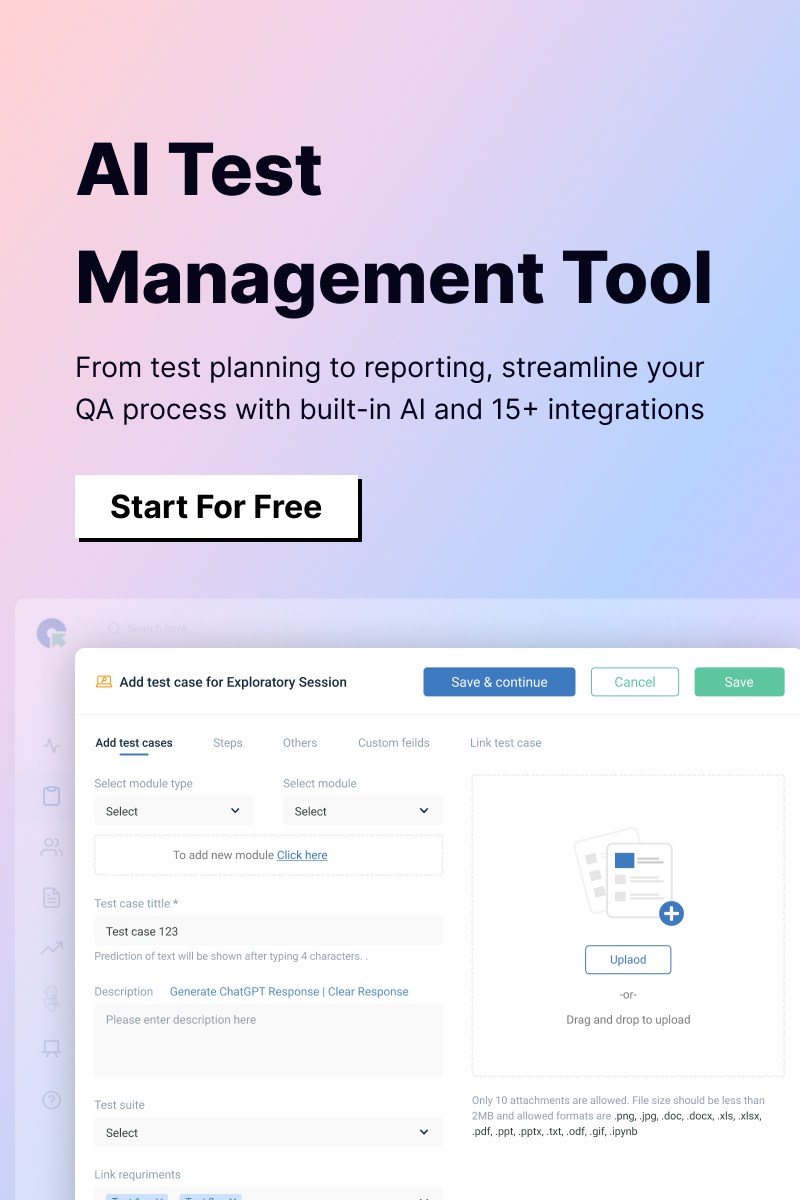A bug-ridden software can impact the overall functionality of the businesses. As a result, testing the software at each development cycle becomes crucial. Integration testing is the second level of the software testing process that comes after unit testing. Integration testing bridges the gap between unit testing and system testing. In this blog, we will cover in detail what integration testing is, its examples, best practices, advantages, how to perform and more. Keep reading to know more!
What is integration testing in software?
In simple words, integration testing is a type of software testing in which the units, components and modules of software are integrated and tested as a whole to check for any bugs or issues.
Let us understand integration testing with a simple analogy:
Imagine you are building a car, and all the car’s components, such as the engine, brakes, steering system, etc., represent a different module. Before launching in the market, you will need to test each of the components individually (unit testing), followed by integration testing, where you start assembling these components together to form the complete car.
For example, you would test how well the engine works with the transmission system, whether the brakes respond correctly when the brake pedal is pressed, whether the steering wheel controls the direction of the car accurately, and whether the electronic components communicate effectively with each other. This ensures that the car as a whole functions perfectly.

Purpose of integration testing?
The primary purpose of integration testing is to ensure that the various software components, elements, and third-party application APIs can work together to achieve the desired performance. By using integration testing, testers can identify and address potential issues like compatibility conflicts, performance bottlenecks, communication errors, and data integrity concerns.
Why is integration testing important?

Softwares are built from many individual software units or components. When tested individually in unit testing, these components may perform fine, but when integrated, the results can be different. Therefore, businesses need to perform integration testing regularly. Here are the reasons why:
- Consistent functionality: It is unlikely that all the software components are coded by the same programmer. This means the logic or approach to development can differ. So, when these components are integrated, they can cause functionality issues. With integration testing, businesses can ensure that these components, when aligned together, lead to a functioning application.
- Incompatibility detection: With proper integration testing, businesses can quickly identify the bugs arising from software/ hardware incompatibility, enhancing overall functionality.
- Early issue resolution: By identifying and resolving integration issues early in the development cycle, businesses can deliver software solutions with a consistent and reliable user experience, leading to higher customer satisfaction and retention.
- Effective scalability: Businesses often need to scale their software systems to accommodate growing user demands or evolving business needs. Integration testing helps ensure that integrated systems can scale effectively without compromising performance or stability.
- Regulatory compliance: Many industries have regulatory requirements and standards that software systems must adhere to. Integration testing helps businesses ensure that their integrated systems comply with these regulations, reducing the risk of penalties or legal issues.
Approaches and types of integration testing
Approaches of integration testing
There are two approaches to performing integration testing- manual and automated.
Manual integration testing
In manual integration testing, testers conduct tests manually to check if different parts of the software work well together. They follow specific steps to simulate real-life situations and observe how these parts interact. Before testing, testers carefully plan which scenarios to cover and what data to use.
During testing, they pay close attention to details like how information is shared between parts and if everything functions as expected. If any issue is identified, it is then documented and passed on to developers for fixing. While manual testing ensures thorough checks, it can take a lot of time and effort, especially for complex software systems.
Automated integration testing
On the other hand, automated integration testing uses tools and software like Selenium and Appium to run tests automatically. Test scenarios are created once and then run repeatedly whenever there are changes to the software. These tests are seamlessly integrated into the software development process, ensuring that integration is checked continuously.
Techniques like mocking are used to simulate parts of the software that are not ready yet. A special test environment is set up to mimic the real world, making sure tests are accurate. While setting up automation requires initial effort, it saves time in the long run and helps deliver reliable software faster.
Types of integration testing
There are two different types of integration testing- the Big Bang approach and the Incremental approach. The incremental approach is further performed using three methods:
- Bottom-up approach
- Top-down approach
- Sandwich approach
Big bang integration testing
In big bang integration testing, all the parts of the software are combined and tested together at once rather than in smaller sections. As a result, the integration process is only carried out when all the components have been successfully unit-tested.
Advantages
- There’s no need to create step-by-step testing procedures, making it straightforward to prepare.
- All components are tested together, which can quickly reveal if major issues exist when everything is combined.
Disadvantages
- If there’s a problem, it’s hard to figure out which part caused it because everything is tested at once.
- Problems in individual modules might go unnoticed until everything is integrated, which can slow down the development process.
- Requires a lot of time and effort to test the entire system at once, which might not be efficient.
Best practices when using big bang testing
- Test individual components separately (unit testing) before conducting the Big Bang test to catch smaller issues early.
- Maintain clear and detailed documentation of all components and their interactions to facilitate faster issue identification.
- Ensure a stable and controlled testing environment to minimize external factors’ impact on test results.
- Having a backup plan in place is crucial in case significant issues arise during testing, allowing for a quick return to a stable state.
- Using monitoring tools like New Relic and Dynatrace to observe the system’s behavior during testing helps identify and address issues as they arise.
Incremental testing
Incremental integration testing is a method where parts of the software are integrated and tested step-by-step, either one at a time or in small groups. This means you combine some modules, test them together, then add more pieces and test again, continuing this process until the entire system is integrated.
Advantages
- Problems are easier to identify and fix because testing is done in small parts.
- Issues are discovered early in the development process, reducing the risk of major problems later on.
- Testing in increments allows for more manageable and controlled testing.
Disadvantages
- Planning and executing tests in small parts can be more time-consuming.
- Requires careful planning to decide the order of integration and testing.
Best practices when using incremental testing
- Carefully decide the order in which parts will be integrated and tested.
- Test each increment thoroughly before moving on to the next.
- Keep track of how different parts depend on each other to ensure they work together properly.
- Maintain clear and up-to-date documentation of each integration step and the results of each test.
- Make sure all tests pass for the current increment before adding more parts.
Next, we will discuss the three different approaches to integration testing: bottom-up, Top-down, and Sandwich. But before that, we need to know low-level and high-level components.
Low-level components
Low-level components are the foundational building blocks of a software system. They include basic functions, routines, and modules that perform essential tasks, such as data processing, database interactions, and utility functions. These components are typically closer to the hardware or core framework of the system and are critical for the system’s basic operations.
High-level components
High-level components are the more complex and user-facing parts of a software system, built on top of low-level components. These include user interfaces, business logic, and application services that directly interact with end-users and manage the overall workflow of the system. High-level components are responsible for processing user inputs, managing data flow between different parts of the application, and providing a cohesive and functional user experience. They rely on the stability and functionality of the low-level components to perform effectively.
Now that you have an idea about low-level and high-level components, let’s move to the bottom-up and top-down approaches.
Bottom-up vs. top-down approach
Let us take simple examples to understand both of these approaches.
Bottom-up approach
In bottom-up integration testing, you start by testing the basic, foundational components first and then move upwards, ensuring each layer is stable before adding the next.
Consider a simplified e-commerce application with the following modules:
- Database Module: Handles database operations.
- Business Logic Module: Contains the core logic for processing orders, calculating totals, etc.
- User Interface (UI) Module: Manages user interactions and displays data.
Steps in Bottom-Up Integration Testing:
1. Test Database Module:
- We start by testing the Database Module independently.
- We then verify that it can perform CRUD operations (Create, Read, Update, Delete) correctly.
2. Integrate and Test Business Logic Module:
- We move to integrating the Business Logic Module with the Database Module.
- Then, we write test cases to ensure the business logic correctly interacts with the database (e.g., retrieving product data, and updating order statuses).
3. Integrate and Test UI Module:
- Finally, we integrate the UI Module with the combined Business Logic and Database Modules.
- Lastly, we test the entire workflow from the user interface down to the database and back.
Top-Down Approach
In top-down integration testing, you start with the high-level components that define the main structure and functionality, then gradually add and test the detailed, lower-level components.
Using the same e-commerce application with the UI, Business Logic, and Database Modules.
Steps in Top-Down Integration Testing:
1. Test UI Module:
- Begin by testing the UI Module independently.
- Use stubs (dummy implementations of lower-level modules) to simulate interactions with the Business Logic Module.
2. Integrate and Test Business Logic Module:
- Integrate the Business Logic Module with the UI Module.
- Replace stubs with the actual Business Logic Module and test the interaction between the UI and business logic.
3. Integrate and Test Database Module:
- Integrate the Database Module with the combined UI and Business Logic Modules.
- Perform end-to-end testing to ensure the UI correctly interacts with the business logic and database.
You should use bottom-up integration testing when:
- Ensuring foundational components are reliable
- Lower-level modules can be independently tested
- Complex logic at the base of the system
- Availability of test drivers for higher-level components
- Reusable lower-level components across projects
You should use top-down integration testing when:
- Validating overall architecture and design early
- Prioritizing user interface and user experience
- Development guided by high-level functionalities
- Availability of stubs for simulating lower-level components
- Early testing needed for complex high-level interactions
Sandwich approach
The sandwich approach, also known as the hybrid approach, involves employing both bottom-up and top-down approaches simultaneously.
Advantages:
- Sandwich integration testing combines both top-down and bottom-up approaches, offering a balanced way to test the software system.
- This approach allows for early detection of both high-level and low-level issues, ensuring comprehensive testing throughout the integration process.
- By integrating and testing from both ends towards the middle, incremental testing is possible, which can help identify and resolve issues early on.
Disadvantages:
- Managing and coordinating both top-down and bottom-up testing approaches simultaneously can be complex and challenging.
- Implementing and managing both testing approaches effectively requires additional resources and time.
You should use the Sandwich approach when:
- Dealing with a complex system with multiple interdependent modules at various levels
- The middle layer (e.g., business logic or application services) is crucial for overall system functionality
- There is a need to balance the testing load between high-level (UI) and low-level (database) modules
- There are time constraints and quicker feedback is needed through iterative testing of different levels.
Tools and frameworks of integration testing
Testers use various testing tools to carry out integration testing:
- JUnit: A popular Java framework for unit testing, also used for integration testing.
- Postman: A tool for API testing and integration testing of web services.
- Selenium: A widely used tool for testing web applications, including integration testing.
- SoapUI: An API testing tool that supports automated testing and validation of SOAP and REST APIs.
- Cucumber: A behaviour-driven development (BDD) tool that supports integration testing through feature files and step definitions.
- TestNG: A testing framework for Java that supports both unit and integration testing.
- PyTest: A testing framework for Python that supports integration testing.
- Katalon Studio: An all-in-one automation testing tool that supports integration testing for web, API, and mobile applications.
- Apache JMeter: A tool for load testing and performance testing, but also supports integration testing of web applications.
Example of integration testing
Here, have a look at the example of integration testing for an eCommerce website:
| Test Case Objective | Test Case Description | Expected Result | |
| 1 | Verify Product Search Integration | This test case ensures that the product search feature integrates correctly with the product database. | Users should be able to search for products using keywords or filters accurately. |
| 2 | Verify Payment Gateway Integration | This test case validates the integration of the payment gateway with the e-commerce platform. | Users should be able to complete transactions smoothly, and payments should be processed securely and accurately. |
| 3 | Verify Order Processing Integration | This test case checks if the order processing system integrates correctly with inventory management. | Orders should be processed accurately, updating the inventory and sending order confirmation emails promptly. |
How does integration testing differ from other software testing types?
Let us now understand what makes integration testing different from the other software testing types:
Integration testing vs unit testing
| Integration Testing | Unit Testing |
| Tests how different modules or components work together as a whole. | Tests individual modules or components in isolation. |
| Requires integrated components to be in place for testing. | Does not require external dependencies and can be done in isolation. |
| Tests interactions between modules and ensures they work together. | Tests the functionality and behavior of individual units/components. |
| Can uncover issues related to component interactions and dependencies. | Unit testing focuses on identifying bugs or defects within individual units. |
| Usually performed after unit testing and before system testing. | Performed before integration testing and system testing. |
Integration testing vs regression testing
| Integration Testing | Regression Testing |
| Ensures that integrated components/modules work together. | Verifies that recent changes haven’t adversely affected existing functionality. |
| Tests interactions between integrated components. | Tests the entire system or a specific set of features. |
| Performed after integration of components/modules. | Regression testing is conducted after new changes are made to the system. |
| Usually executed during each integration cycle. | Often performed before each release or deployment. |
Integration testing vs system testing
| Integration Testing | System Testing |
| Ensures that integrated components/modules work together. | Validates the entire system’s functionality and behavior. |
| Focuses on testing interactions between integrated components. | Tests the system as a whole, including all integrated components and external interfaces. |
| Designed to cover interactions between integrated components. | System testing is designed to cover end-to-end scenarios and user workflows. |
| Requires all integrated components to be in place for testing. | May require a stable environment and test data for comprehensive testing. |
| Ensures smooth integration and interoperability of components. | Validates the system’s readiness for release and user acceptance. |
Integration testing vs end-to-end testing
| Integration Testing | End-to-End Testing |
| Focuses on testing interactions between integrated components. | Tests the entire system from start to finish, including all integrated components and external interfaces. |
| Performed after integration of components/modules. | Conducted after integration testing and before user acceptance testing. |
| Tests how different parts of the system work together. | End-to-end testing verifies that the system behaves as expected in real-world scenarios. |
| Designed to cover interactions between integrated components. | Designed to cover user journeys and end-to-end workflows. |
| Requires all integrated components to be in place for testing. | May require a stable environment and realistic test data for comprehensive testing. |
How to conduct integration testing?
Here’s a step-by-step process of conducting integration testing:
1. Define Scope of Integration Testing: The first step in conducting integration testing is to create a clear scope and objectives for the project. The scope will define which modules or components should be included in the integration testing, along with the system’s limitations and dependencies. The objectives will define what you want to verify and achieve in the test, such as security, functionality, reliability, or compatibility.
2. Identify Integration Points: We begin with identifying the integration points where different components interact. These interaction points are crucial for integration testing, as they represent the interfaces where data, control, or communication flow between integrated components.
3. Develop Test Cases: Then, we need to develop test cases that will cover the interactions between integrated components. These test cases should validate the data flow, communication protocols, and functionality of integrated modules.
Here is a look at the best practices for writing test cases:
- Understand integration points and interactions between components/systems thoroughly.
- Define clear and concise test scenarios covering various integration paths and edge cases.
- Focus on end-to-end functionality validation across integrated components/systems.
- Use mocks or stubs to simulate external dependencies not under direct control for isolated testing.
- Include negative test cases to verify error handling and exception scenarios.
- Document test cases with preconditions, steps, and expected results for clarity and traceability
4. Set Up Test Environment: We need to set up a test environment that mirrors the production environment as closely as possible. This includes deploying the integrated components and configuring necessary dependencies.
5. Execute Test Cases: We will then execute the developed test cases in the test environment. This involves simulating various scenarios, inputs, and conditions to test different integration points.
6. Monitor and Record Results: Next step is to monitor the behavior of integrated components during testing and record the results. This includes verifying that the components perform their functions as expected.
7. Analyze and Debug Issues: Finally, we analyze the test results to identify discrepancies, errors, or failures. We will also debug issues by isolating the root cause and fixing the integration issues between components.
8. Iterate and Retest: Based on the identified issues, we will adjust the integrated components and retest the system to ensure the integration problems are resolved. We will repeat this process until all integration issues are addressed satisfactorily.
9. Document Findings: Document the findings, including successful integrations, identified issues, and resolutions. This documentation serves as a reference for future integration testing efforts and system maintenance.
- Use a standardized format for documenting findings, including clear headings and sections.
- Classify issues based on severity to prioritize resolution efforts effectively.
- Provide detailed descriptions of identified issues, including symptoms and root causes.
- Document step-by-step instructions for reproducing each issue to facilitate debugging.
- Outline resolutions implemented for each issue, along with validation steps to ensure effectiveness.
- Encourage collaborative review and feedback from stakeholders to enhance documentation quality and accuracy.
With its advanced features, a test management tool like QA Touch can help with integration testing. For instance, you can utilize QA Touch’s audio and screen recording feature to capture test execution sessions, including interactions, observations, and issues encountered during integration testing. This helps you streamline the software testing process and boost the efficiency of the QA testing team.
10. Review and Validate: Lastly, we review the integration testing process and results with stakeholders to ensure that the integrated system meets the desired requirements and specifications.
Best practices of Integration testing
Here are some of the best practices that testers can keep in mind when performing integration testing:
- It is essential to plan and design functional requirements and integration testing early in the development process to ensure that the components are combined and tested without any issues.
- You must monitor the test results to identify and address the issues found on time.
- Collaboration is crucial for integration testing. You must ensure that the different teams involved in software development, such as the testing team, development team, and operations, communicate effectively.
- Lastly, you must make sure that all possible combinations and scenarios are integrated and tested to ensure that the components work together correctly under different conditions.
Advantages and challenges of Integration testing
Let us now have a look at the advantages and challenges of integration testing:
Advantages:
- Finds problems early so they don’t become significant issues later.
- Identifies if all parts work together correctly.
- Makes sure the whole system works well, improving overall quality.
- Lowers the chances of substantial failures later on.
Challenges:
- It can be hard to manage in extensive systems with lots of parts.
- It needs access to other systems or services, which can be tricky.
- It takes time, effort, and resources to set up and run.
- Finding and fixing problems is harder when parts interact.
- Sometimes, repeated testing is already done in other stages, adding more work.
How software management tools can help with integration testing
Integration testing plays a significant role in software development by ensuring that different software components can work together. This testing approach helps detect bugs early, maintain system integrity, improve software quality, and reduce the risk of failures during deployment.
Businesses can utilize integration testing to build reliable software solutions that meet the ends of their users. We at QA Touch ensure that your QA testing process is seamless and without any issues. From planning and execution to defect tracking, our Test Management Platform lets you handle the complete testing process using a single platform. You can also enjoy features like Chat GPT-driven test case creation, Built-in bug tracking, Multi-lingual support and many more.
Make the most out of software testing with QA Touch- Sign up today.















